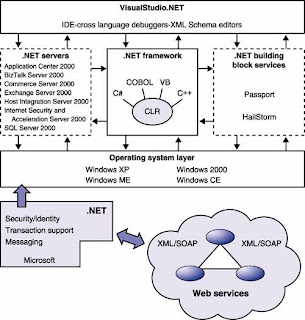.NET is designed for Windows platforms.
Figure 6.3 illustrates the Microsoft .NET Platform, which consists of five main components.
At the lowest layer lies the operating system, which can be one of a variety of Windows platforms, including Windows XP, Windows 2000, Windows ME, or Windows CE. As part of the .NET strategy, Microsoft is planning to deliver more .NET device software to facilitate a new generation of smart devices.
Figure 6.3 illustrates the Microsoft .NET Platform, which consists of five main components.
At the lowest layer lies the operating system, which can be one of a variety of Windows platforms, including Windows XP, Windows 2000, Windows ME, or Windows CE. As part of the .NET strategy, Microsoft is planning to deliver more .NET device software to facilitate a new generation of smart devices.

Figure 6.3
At the top layer of the .NET architecture is VisualStudio.NET (also called VS.NET). VS.NET is designed to support the rapid development of Web services through an Integrated Development Environment (IDE) that supports multiple languages, cross-language debugging, and an XML Schema Editor for defining XML vocabularies.
No comments:
Post a Comment